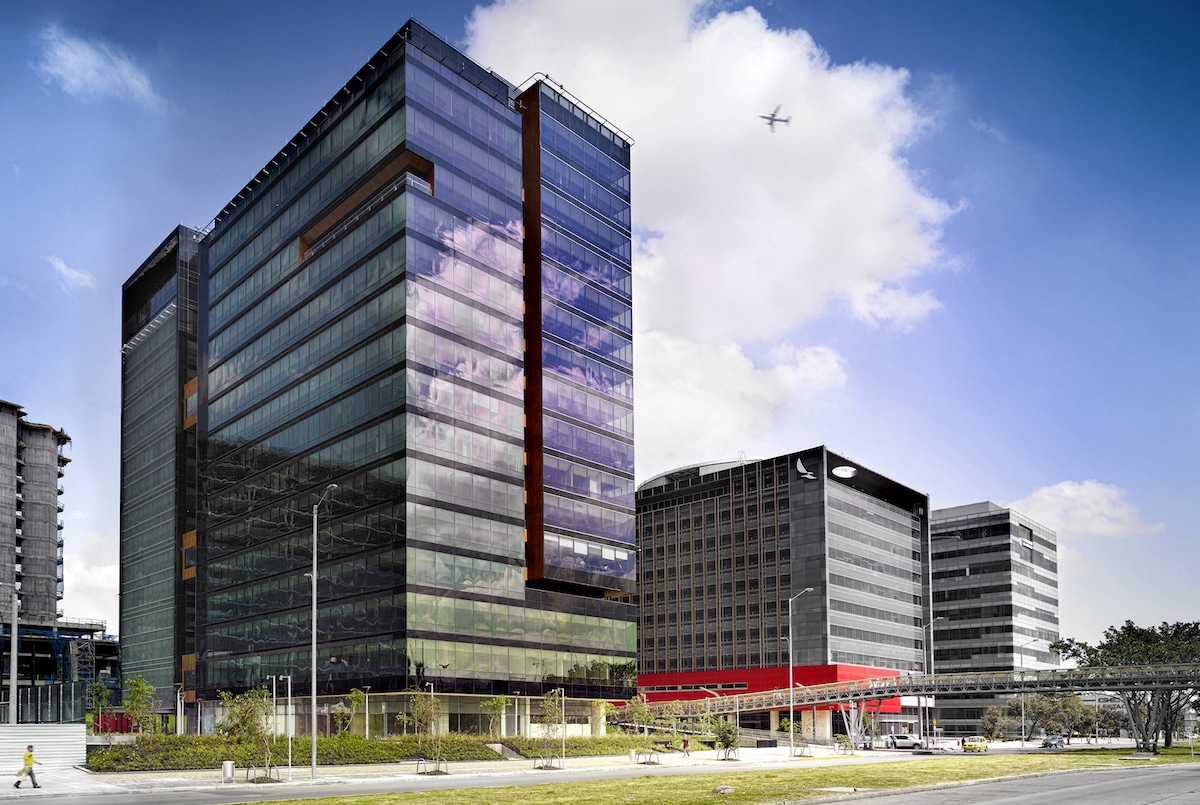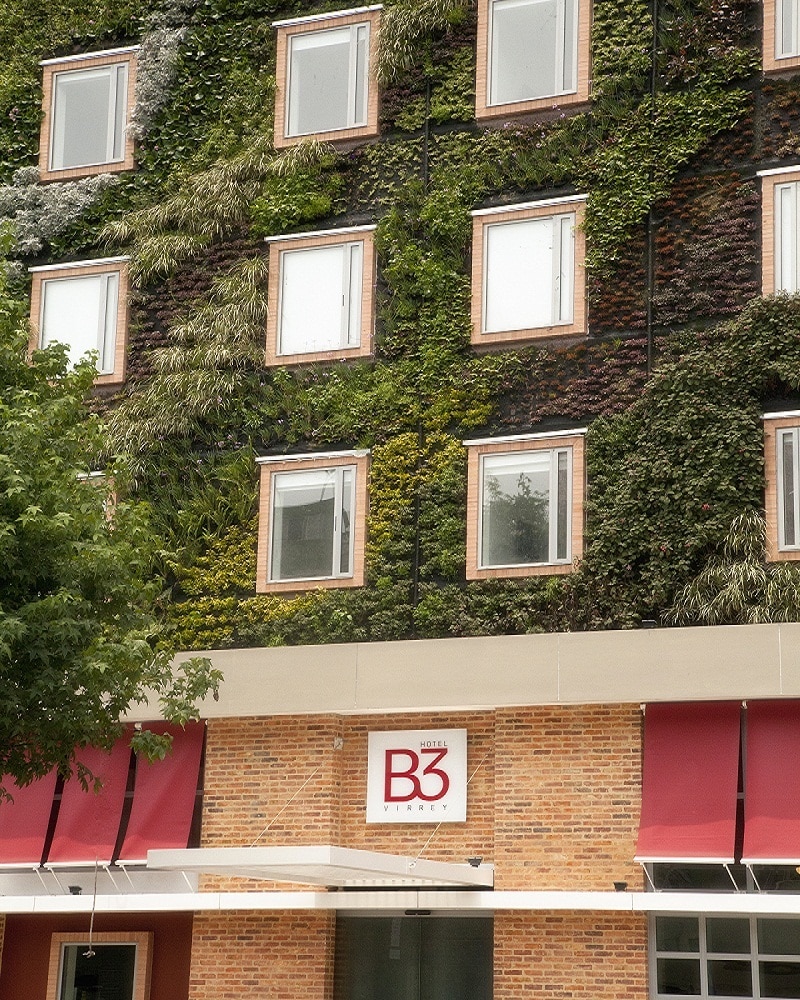
[Photo: Courtesy of ProColombia]
Bogotá is in the midst of a green transformation as it prepares for an influx of both residents and tourists.
Chances are, if you know anything about Colombia, it’s not great. It’s what you’ve learned from binge-watching Narcos on Netflix, maybe, or what you remember from the headlines of the ’80s and ’90s. And while the city of Bogotá (population 8 million) was considered to be one of the most violent cities in the world in the ’90s, the Bogotá of today is a vastly different, healthier and happier place.
Today’s Bogotá is both beautiful and complex. It’s also very, very busy. Motorcycles weave in and out of rush hour traffic—private cars, taxis, and now hybrid buses alike—and bicycles rush down side streets while plenty of others take to the sidewalks to get home. These days when you hit the road in this city below the Andes Mountains, you’ll see all modes of transportation, all kinds of people, and, increasingly, all types of architecture, as the city commits to green building.
“We want the city to be as compact as possible, but also to be adaptive to climate change and as low as it can be in terms of consumption,” says Cristina Gamboa, director and CEO of the Colombia Green Building Council (Consejo Colombiano de Construcción Sostenible, CCCS).
Since 2009, the CCCS has been part of the World Green Building Council. The group currently represents the BEA, or Building Efficiency Accelerator program—a World Resources Institute initiative that recruits cities to be climate change activists in response to the Paris Agreement. As such, Bogotá is increasingly looking at establishing and fine-tuning public policy that flags buildings as a priority for reducing greenhouse gas emissions.

[Photo: Courtesy of Consejo Colombiano de Construcción Sostenible]
Preparing for Continued Growth
Currently, 78% of Colombia’s population lives in cities, and 18 million Colombians are expected to move to cities by 2050, Gamboa says. Bogotá is expected to need 2.7 million more houses by 2050, and the population is projected to exceed 10 million people by 2030, according to a UN report. “How do you prepare for that?” Gamboa says. “It’s really big.”
Colombia is a middle income country, with a middle class that’s growing. The potential is great—both for tourism and green development. “We are an investment grade economy so investors—multinationals particularly—are also demanding these types of spaces. They know the equation and they demand green office space and industry,” Gamboa says.
SEE ALSO: The New Path to Monserrate Marches Ahead in Sustainability
She says the city is tightening its code so new buildings—including required affordable housing—are more efficient, too. The new code will provide a performance pathway for all new buildings to improve, setting targets for water and energy savings, after establishing a baseline using ASHRAE and the International Plumbing Code. It’s also looking at overall social sustainability—is the city accessible to all?—and economic competitiveness. “How do you get the best city in terms of the urban space for it to still attract foreign direct investment and for it to grow and be competitive?”

[Photo: Courtesy of ProColombia]
Leading by Example
Bogotá is one of 30 BEA cities in the world and is in the midst of drafting a new master plan for the next 12 years to improve quality of life in the city. “Bogotá is really committed to having a legacy of being resilient,” Gamboa says. “With this project, the city is really going to be a leader in the Colombian context. It’s going to be the first energy code of Colombia.”
SEE ALSO: A History of Resourceful Architecture in Bogotá
The plan asks that new buildings reduce their greenhouse gas emissions by 32%. “We’re going to impact 2.7 million new homes, and those new homes will see their utilities reduced by 25%,” Gamboa says. She says Bogotá will lead the way to make green building accessible—and not necessarily using only certifications. She says while certifications are important and inspire people to do better, designations like LEED have also been improved by alternative compliance pathways that allow documentation for natural ventilation, considering how Bogotá, for example, doesn’t experience seasons. “It’s important that LEED could have a protocol that you can document engineered natural ventilated projects and achieve LEED.”
In 2016, the Colombia Green Building Council delivered just that, proposing a new pathway for naturally ventilated projects in Latin America, allowing for verification of achieved environmental indoor air quality.

[Photo: Courtesy of Planned Constructions]
Green Building is Good Business
Building owners in Bogotá increasingly understand the benefit of healthy buildings and want to implement better materials and practices in their projects, too. “All of these developers, all of these leaders, started seeing in this market a way to deliver value,” Gamboa says.
A study a few years ago showed that builders choosing to build green initially built that way because they believed it was the right thing to do. “Now it’s also clearly understood it’s the best business possible.” Colombia began building to LEED standards in 2008 and, as of March 2018, had more than 350 LEED projects. “Colombia represents approximately 10% of LEED in the Latin American market.”
Gamboa says there’s a “green premium” for office space, hospitals, and schools alike now. “Last year we drafted some basic guidelines for sustainability in public schools in Colombia because the Ministry of Education is now convinced these types of spaces are what kids need to thrive and learn. Now the movement that started with private sector leadership has the added value of having the public sector understanding the benefits in promoting it.”
SEE ALSO: How Bogotá is Reinventing Library and School Design
That, she says, is leadership. “And also the other agencies are coming through and delivering with financial sector incentives. That, for a developing country, is quite significant.”
Buildings like the Elementos—four LEED Platinum towers on Avenue 26—are an example of what can be done with recycled content, solar panels, a green roof, low-emitting materials, and countless other sustainable building features. Certified in 2017, this project allowed for 67% savings in water and 48% in energy overall, and it’s 100% naturally ventilated.
On the same street you’ll find the T7/T8 Business Tower, LEED Gold certified in 2017. Sustainable building strategies and a careful selection of lights, faucets, and other equipment resulted in a savings of 15% energy and 38% water, compared to traditional offices. The tower was built with 28% recycled materials—44% of which come from the region.

[Photo: Courtesy of ProColombia]
The Future
In the past, the city has struggled with administrations that didn’t do much to progress the mission of sustainability, Gamboa says, but Mayor Enrique Peñalosa began to change that in his first term. The mayor’s office is currently working to also promote mixed use development that includes affordable housing. And there’s an emphasis on working with—not against—nature, so development doesn’t hurt local wetlands and instead gives people access to nature.
“We’re doing world-class buildings in Colombia,” Gamboa says. “We can do something that is really meaningful.”
Biking and More
Bogotà is recognized internationally for its transit oriented development strategy—from the TransMilenio buses to its renowned bicycle program, the Ciclovia. Since the 1970s, more than 70 miles of main streets in the city are shut down to vehicle traffic on Sundays from 7am to 2pm so people can bike. About a quarter of the city’s population turn out for it on average every week.
The city also prohibits driving every day—half of the week you simply can’t. Residents follow a system monitored by the numbers on their license plates, which correspond to the days they’re permitted to drive.
Embracing Ecotourism
Locals and tourists alike are changing in Bogotá, and that means how people spend their time is evolving, too—from more people on bikes (check out Bogotá Bike Tours) to a growing need for sustainable lodging (try Biohotel Organic Suites). These are just a few of our favorite eco-friendly spots in the city.
1. Juan Valdez Origenes
In Zone G of Bogotá, in an area vibrant with restaurants, bars, and hotels, you’ll also find the three-floor Juan Valdez Origenes, the company’s first experiential store and cafe. Here, tables are stamped with a designation showing they’re made from 100% sustainable wood and a towering living wall makes you feel as though you’ve escaped into the forest. juanvaldezcafe.com/es-co/juan-valdez-cafe-origenes

[Photo: Courtesy of B3 Hotel]
2. B3 Hotel
There’s no mistaking the B3 hotel’s commitment to green—the first thing you see is its nine-story vertical garden with 25,000 plants on the building’s exterior. This affordable lodging option (rooms start at $50) is close to a beautiful park and an easy walk to great dining and drinking.
The hotel further proves its commitment to the environment by encouraging guests to borrow one of its bikes. B3 has also eliminated often unused amenities like mini bars, which waste energy. hotelesb3.com/en

[Photo: Jackie Frysz]
3. Canasto Picnic Bistro
In one of the most charming areas of Bogotá, just across the street from the popular Virrey Park, you’ll find this oasis of fresh, flavorful, and local ingredients. Don’t miss Canasto’s brunch, with heavenly concoctions served in a greenhouse-style setting surrounded by natural light and a vast amount of hanging plants. canasto.co
More Green Escapes:
- Biohotel Organic Suites
- Bogotá Bike Tours
- Monserrate
- Quebrada Las Delicias
- Virgilio Barco Library
- Virrey Park
